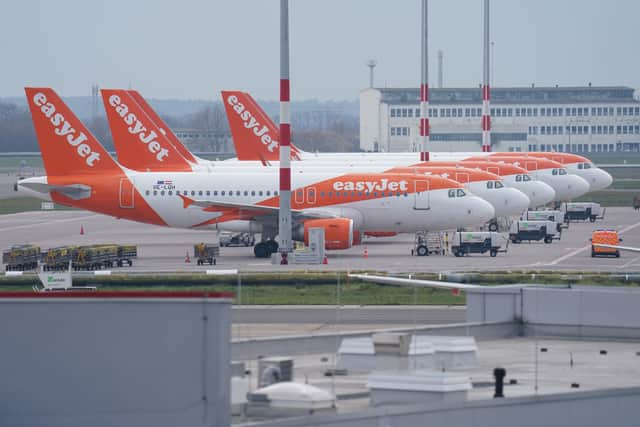EasyJet UK: history behind the low budget airline - where does it fly to and how does it compare to Ryanair and Wizz Air?
and live on Freeview channel 276
The low budget airline easyJet celebrated its 28th birthday this year and has come a long way since it was founded by Greek-Cypriot entrepreneur Stelios Haji-Ioannou in 1995. It launched its first two flights across the UK in 1995 with the route of Luton to Glasgow beginning on 10 November and Luton to Edinburgh launched on 24 November. Now the carrier boasts over 180 destinations across its European and North African network.
On Thursday 12 October easyJet announced it will order new aircraft and resume dividend payments to shareholders after it made a record profit this summer. The airline said it expects its profit before tax between July and September to be between £650 million and £670 million, driven by an 8% increase in passenger numbers and a 9% rise in fares. EasyJet’s CEO Johan Lundgren said its positive performance shows its “strategy is achieving results” and the new aircraft “will enable easyJet’s fleet modernisation and growth to continue beyond 2028”.
Advertisement
Hide AdAdvertisement
Hide AdAs the airline announces its record high profits, we take a look back at the history of easyJet delving into how it became the firm it is today, where it now flies to and how big it is compared to its rival airlines Ryanair and Wizz Air.
The history of easyJet
By reinvesting the returns made on its first local routes in 1995, the company took delivery of its first wholly-owned plane, a Boeing 737-300. It was delivered in April 1996 with easyJet then launching its first international services.
Amsterdam was chosen as its first destination outside the UK. The low-cost carrier then opened its second UK base at Liverpool Airport in the autumn of 1997.


Following this the brand took advantage of the internet and started promoting bookings on easyJet.com which helped see profits rise. The carrier then welcomed over 80 Boeing 737s during the 90s and early-2000s - which the Airbus A320-family would eventually replace.
Advertisement
Hide AdAdvertisement
Hide AdDuring this period, the airline invested in Swiss charter operation, TEA Basel AG, changing its name to "easyJet Switzerland". This allowed the carrier to launch services from Geneva to Nice, Amsterdam, and Barcelona. These routes became the first easyJet services flown entirely outside the UK.
Founder, Stelios, helped the brand to connect with its customers through his charismatic and transparent personality. He was welcomed into the UK Travel and Hospitality Hall of Fame in May 2004 and ordered 120 Airbus A319s to add to his growing fleet. Subsequently, the firm became the first major low-cost airline to offer online check-in for UK passengers. By 2010, the low-cost airline reached 500 destinations and was voted the Best Low-Fares Airline for the tenth year in a row at the Business Traveller magazine awards.
Over the pandemic, which brought air travel to a halt, easyJet racked up over £2 billion in losses. The carrier managed to stay afloat and towards the end of last year trends started to pick up. The airline has enjoyed its busiest-ever summer, exceeding its 2019 capacity by around 9%.
Where does easyJet fly to?
EasyJet now flies extensively across Europe and beyond including to France, Italy, Germany, Spain, across Scandinavia, eastern Europe, the Balkan states, north Africa and near Middle East . It boasts a huge number of destinations. Passengers can see all of the routes easyJet flies to on the airline’s route map.
Advertisement
Hide AdAdvertisement
Hide AdHow does it compare to other rival airlines?
Consumer watchdog, Which?, invited more than 8,000 passengers to rate their carriers across a range of criteria. Jet2.com came out top with an overall customer score of 80%. At the bottom of the table was Wizz Air with 48%, Ryanair scored 52%, while easyJet and Tui Airways scored 59%.
Out of Europe’s three low-cost giants - easyJet, Ryanair and Wizz Air - easyJet offers the largest free hand luggage allowance. All of its passengers are entitled to bring a single cabin bag onboard for no charge, with its dimensions measuring up to 45 cm x 36 cm x 20 cm. Ryanair allows its passengers to bring one free cabin bag with them with dimensions not allowed to exceed 40 cm x 25 cm x 20 cm. While Wizz Air allows 40 x 30 x 20 cm.
An investigation by the Civil Aviation Authority this year found that Wizz Air is the airline most likely to be delayed in the UK. It came after the airline was found to be the worst the year before. Passengers flying from UK airports on the Hungarian carrier were delayed by 46 minutes and six seconds on average in 2022, according to analysis of Civil Aviation Authority (CAA) data by the PA news agency. Ryanair passengers were delayed 22 minutes and easyJet 20 minutes and 24 seconds.
Comment Guidelines
National World encourages reader discussion on our stories. User feedback, insights and back-and-forth exchanges add a rich layer of context to reporting. Please review our Community Guidelines before commenting.
